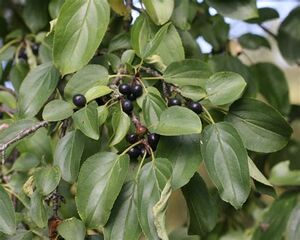Rhamnus cathartica (Common Buckthorn): Difference between revisions
No edit summary |
No edit summary |
||
| Line 32: | Line 32: | ||
== Description == | == Description == | ||
''Rhamnus cathartica'' is a medium to large sized woody plant..<ref name="Book">George A. Petrides, "The Peterson Field Guide Series: A Field Guide to Trees and Shrubs", ''Boston: Houghton Mifflin Company'', 1986. ISBN: 0-395-17579 "</ref> Twigs end in sharp spines, and are usually dark and unlined.<ref name="Book"></ref> Leaves are elliptic, hairless, and finetoothed, usually 1 1/2" to 2".<ref name="Book"></ref> Plant usually flowers from May to June, small, greenish, clustered blooms. Fruits are dark and berrylike.<ref name="Book"></ref> | ''Rhamnus cathartica'' is a medium to large sized woody plant..<ref name="Book">George A. Petrides, "The Peterson Field Guide Series: A Field Guide to Trees and Shrubs", ''Boston: Houghton Mifflin Company'', 1986. ISBN: 0-395-17579 "</ref> Twigs end in sharp spines, and are usually dark and unlined.<ref name="Book"></ref> Leaves are elliptic, hairless, and finetoothed, usually 1 1/2" to 2".<ref name="Book"></ref> Plant usually flowers from May to June, small, greenish, clustered blooms. Fruits are dark and berrylike.<ref name="Book"></ref> Although leaves usually exhibit opposite growth form, older growth may display alternate.<ref name="Book"></ref> | ||
== Ecology == | == Ecology == | ||
Revision as of 16:26, 16 May 2022
Rhamnus cathartica also known as Common Buckthorn, Purging buckthorn, European buckthorn, or buckthorn is a plant native to calcareous soils throughout England, into Scandaninavia and across Russia into western Asia, as well as being found as far south as Morocco and Algeria.[1] Buckthorn was introduced to the United States as early as the 1800s as an ornamental shrub by, and is now common across many of the lower 48 states as an invasive species.[2]

| |
| Kingdom: | Plantae |
|---|---|
| Phylum: | Magnoliophyta |
| Class: | Magnoliopsida |
| Order: | Rhamnales |
| Family: | Rhamnaceae |
| Genus: | Rhamnus L |
| Species: | R. cathartica L. |
| Source: United States Department of Agriculture[3] | |
Description
Rhamnus cathartica is a medium to large sized woody plant..[4] Twigs end in sharp spines, and are usually dark and unlined.[4] Leaves are elliptic, hairless, and finetoothed, usually 1 1/2" to 2".[4] Plant usually flowers from May to June, small, greenish, clustered blooms. Fruits are dark and berrylike.[4] Although leaves usually exhibit opposite growth form, older growth may display alternate.[4]
Ecology
Allelopathy
Impact as an Invasive Species

Uses
R. cathartica is a purgative, meaning that it may cause stomach cramps through toxins, especially emodin, present in its berries and shoots.
References
- ↑ O. W. Archibold, D. Brooks, L. Delanoy, "An Investigation of the Invasive Shrub European Buckthorn Rhamnus cathartica L., near Saskatoon, Saskatchewan", The Canadian Field-Naturalist. October 1997. Retrieved 5/16/2022.
- ↑ Kathleen S. Knight, Jessica S. Kurylo, Anton G. Endress, J. Ryan Stewart, Peter B. Reich, "Ecology and ecosystem impacts of common buckthorn (Rhamnus cathartica): a review", Biological Invasions (2007) 9:925-937. 13 February 2007. doi: 10.1007/s10530-007-9091-3. Retrieved 5/16/2022.
- ↑ "Rhamnus Cathartica Plant Profile", USDA "USDA Natural Resource Conservation Service", USDA, n.d.. Retrieved 5/16/2022.
- ↑ 4.0 4.1 4.2 4.3 4.4 George A. Petrides, "The Peterson Field Guide Series: A Field Guide to Trees and Shrubs", Boston: Houghton Mifflin Company, 1986. ISBN: 0-395-17579 "